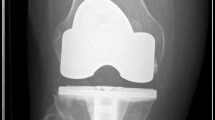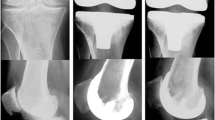Abstract
Purpose
Introduced in the market in 1990 by Ceraver (France), the posterior-stabilised (PS) Hermes prosthesis has limited literature regarding long-term survivability. The purpose of the study is to evaluate the survival and functional outcomes of the prosthesis.
Methods
A retrospective case series was performed including 164 patients (176 knees) having undergone total knee arthroplasty with the Hermes prosthesis between 1997 and 2000 with a follow-up period of 18 years.
Results
Kaplan–Meier analysis showed a survival rate of 99.4% (95% CI. 96.0–100.0%) at 18.4 years with one revision. At final follow-up, the International Knee Society (IKS) functional score was 93.2 ± 15.6 and IKS knee score was 99.1 ± 2.5.
Conclusion
The Hermes PS model is a low conformity prosthesis that offers reliable durability that is comparable to other popular designs while minimizing rotational constraints and having an approachable learning curve for new users.





Similar content being viewed by others
Data availability
Available upon request.
Code availability
Not applicable.
References
Abdelgaied A, Brockett CL, Liu F, Jennings LM, Jin Z, Fisher J (2014) The effect of insert conformity and material on total knee replacement wear. Proc Inst Mech Eng H 228(1):98–106
Argenson JN, Boisgard S, Parratte S et al (2013) Survival analysis of total knee arthroplasty at a minimum 10 years’ follow-up: a multicenter French nationwide study including 846 cases. Orthop Traumatol Surg Res 99(4):385–390
Bartel DL, Bicknell VL, Wright TM (1986) The effect of conformity, thickness, and material on stresses in ultra-high molecular weight components for total joint replacement. J Bone Joint Surg Am 68(7):1041–1051
Bédard M, Vince KG, Redfern J, Collen SR (2011) Internal rotation of the tibial component is frequent in stiff total knee arthroplasty. Clin Orthop Relat Res 469(8):2346–2355
Bhatt H, Rambani R, White W, Chakrabarty G (2012) Primary total knee arthroplasty using the P.F.C Sigma®-rotating platform cruciate retaining endoprosthesis–a 6 year follow up. Knee 19(6):856–859
Châtain F, Gaillard TH, Denjean S, Tayot O (2013) Outcomes of 447 SCORE® highly congruent mobile-bearing total knee arthroplasties after 5–10 years follow-up. Orthop Traumatol Surg Res 99(6):681–686
Czekaj J, Fary C, Gaillard T, Lustig S (2017) Does low-constraint mobile bearing knee prosthesis give satisfactory results for severe coronal deformities? A five to twelve year follow up study. Int Orthop 41(7):1369–1377
Delanois RE, Mistry JB, Gwam CU, Mohamed NS, Choksi US, Mont MA (2017) Current epidemiology of revision total knee arthroplasty in the United States. J Arthroplasty 32(9):2663–2668
Hack J, Mai S, Siebert W (2015) Zehn-Jahres-Ergebnisse nach bikondylärem Kniegelenksersatz mit der kreuzbanderhaltenden Knietotalendoprothese NexGen CR [10-Year Follow-Up of the NexGen CR Total Knee Prosthesis]. Z Orthop Unfall 153(5):508–515
Hernigou P, Manicom O, Flouzat-Lachaniete CH, Roussignol X, Filippini P, Poignard A (2009) Fifteen year outcome of the ceraver hermes posterior-stabilized total knee arthroplasty: safety of the procedure with experienced and inexperienced surgeons. Open Orthop J 3:36–39
Inacio MCS, Paxton EW, Graves SE, Namba RS, Nemes S (2017) Projected increase in total knee arthroplasty in the United States — an alternative projection model. Osteoarthritis Cartilage 25(11):1797–1803
Jauregui JJ, Cherian JJ, Pierce TP, Beaver WB, Issa K, Mont MA (2015) Long-term survivorship and clinical outcomes following total knee arthroplasty. J Arthroplasty 30(12):2164–2166
Kim YH, Park JW, Kim JS, Kulkarni SS, Kim YH (2014) Long-term clinical outcomes and survivorship of press-fit condylar sigma fixed-bearing and mobile-bearing total knee prostheses in the same patients. J Bone Joint Surg Am 96(19):e168
Klug A, Gramlich Y, Rudert M et al (2021) The projected volume of primary and revision total knee arthroplasty will place an immense burden on future health care systems over the next 30 years. Knee Surg Sports Traumatol Arthrosc 29(10):3287–3298
Koh YG, Son J, Kwon OR, Kwon SK, Kang KT (2019) Tibiofemoral conformity variation offers changed kinematics and wear performance of customized posterior- stabilized total knee arthroplasty. Knee Surg Sports Traumatol Arthrosc 27(4):1213–1223
Kurtz S, Mowat F, Ong K, Chan N, Lau E, Halpern M (2005) Prevalence of primary and revision total hip and knee arthroplasty in the United States from 1990 through 2002. J Bone Joint Surg Am 87(7):1487–1497
Kurtz SM, Ong KL, Lau E et al (2011) International survey of primary and revision total knee replacement. Int Orthop 35(12):1783–1789
Labek G, Thaler M, Janda W, Agreiter M, Stöckl B (2011) Revision rates after total joint replacement: cumulative results from worldwide joint register datasets. J Bone Joint Surg Br 93-B(3):293–297
Lavoie F (2017) Spacer-based gap balancing in total knee arthroplasty: clinical success with a reproducible technique. J Knee Surg 30(8):798–806
Le Stum M, Gicquel T, Dardenne G, Le Goff-Pronost M, Stindel E, Clavé A (2023) Total knee arthroplasty in France: male-driven rise in procedures in 2009–2019 and projections for 2050. Orthop Traumatol Surg Res 109(5):103463
Mayne A, Harshavardhan HP, Johnston LR, Wang W, Jariwala A (2017) Cruciate retaining compared with posterior stabilised Nexgen total knee arthroplasty: results at 10 years in a matched cohort. Ann R Coll Surg Engl 99(8):602–606
Pabinger C, Berghold A, Boehler N, Labek G (2013) Revision rates after knee replacement. Cumulative results from worldwide clinical studies versus joint registers. Osteoarthr Cartilage 21(2):263–268
Rasquinha VJ, Ranawat CS, Cervieri CL, Rodriguez JA (2006) The press-fit condylar modular total knee system with a posterior cruciate-substituting design. A concise follow- up of a previous report. J Bone Joint Surg Am 88(5):1006–1010
Riaz O, Aqil A, Sisodia G, Chakrabarty G (2017) P.F.C Sigma® cruciate retaining fixed-bearing versus mobile-bearing knee arthroplasty: a prospective comparative study with minimum 10-year follow-up. Eur J Orthop Surg Traumatol 27(8):1145–1149
Trent PS, Walker PS (1976) Wear and conformity in total knee replacement. Wear 36(2):175–187
Author information
Authors and Affiliations
Contributions
Dr Pitsaer participated in conceptualisation, investigation, methodology, project administration, formal analysis, and review/editing of the study. Dr Chergui performed data curation, formal analysis, visualisation, manuscript writing, and review/editing. Dr Lavoie was involved in project administration, supervision, validation, and review/editing.
Corresponding author
Ethics declarations
Consent for publication
Publication consent was obtained from all individual participants included in the study.
Informed consent
Informed consent was obtained from all individual participants included in the study.
Conflict of interest
The authors declare no competing interests.
Additional information
Publisher's Note
Springer Nature remains neutral with regard to jurisdictional claims in published maps and institutional affiliations.
Level of evidence: Level IV (Case series).
Rights and permissions
Springer Nature or its licensor (e.g. a society or other partner) holds exclusive rights to this article under a publishing agreement with the author(s) or other rightsholder(s); author self-archiving of the accepted manuscript version of this article is solely governed by the terms of such publishing agreement and applicable law.
About this article
Cite this article
Pitsaer, E., Chergui, S. & Lavoie, F. Long-term results of a rotationally unconstrained fixed-bearing total knee prosthesis. International Orthopaedics (SICOT) 48, 965–970 (2024). https://doi.org/10.1007/s00264-024-06097-5
Received:
Accepted:
Published:
Issue Date:
DOI: https://doi.org/10.1007/s00264-024-06097-5




